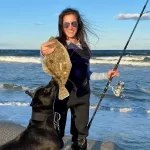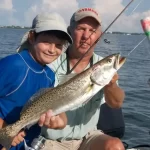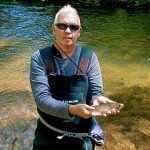7 Useful Flounder Fishing Tips
In this post we will feature 7 useful flounder fishing tips. Flounder are a very popular species targeted by anglers all along the coasts of the Atlantic Ocean and Gulf of Mexico. They put up a nice little scrap, however they are mostly prized for their incredible fillets. While fishing for flounder is not complicated, there are some specialized techniques that will help anglers be more successful.
7 useful flounder fishing tips
Capt Jim Klopfer is a fishing charter captain in Sarasota, Florida. He grew up in Maryland, fishing Chesapeake Bay and other saltwater areas. Capt Jim has caught flounder all over the east coast of the United States. He shares some flounder fishing tips in this article!
The 7 useful flounder fishing tips are;
- present baits or lures right on the bottom for flounder
- constantly moving baits or lures will produce more flounder
- jigs are effective flounder fishing lures
- minnows and shrimp are the top live baits for flounder
- flounder are structure oriented fish
- strips of cut bait are very effective flounder baits
- understand how tides will affect flounder fishing
Best flounder fishing tackle
There is no special tackle required for flounder fishing. The same tackle anglers use for inshore saltwater fishing for species such as redfish and striped bass will work fine when chasing flounder as well. A medium spinning outfit and a light conventional outfit will cover just about every flounder fishing situation.
Anglers can read more about flounder and fluke fishing tackle
Spinning tackle works well when casting lighter lures and baits as well as when fishing in fairly shallow water. Lighter sinkers and lures will be used in these waters and spinning tackle will handle this job just fine. A 7 foot medium action spinning rod with a 3000 series reel spooled up with 20 pound braided line is an excellent all round combination.
Click links to shop Amazon for Penn spinning and conventional outfits
“Fishing Lido Key is a participant in the Amazon Associates Program, an affiliate advertising program designed to provide a means for sites to earn advertising fees by advertising and linking to Amazon. As an Amazon Associate I earn from qualifying purchases. ”
Conventional tackle works well when flounder fishing in deeper water or and stronger currents. The heavier rod and more powerful reel will work better when drifting or fishing with weights in excess of several ounces. It is also better when catching larger flounder around heavy cover. A medium light conventional rod between 6 feet long and 7 feet long with a matching reel and 30 pound braided line will get the job done.
Flounder are caught on the bottom
Flounder spend the vast majority of their time on or very near the bottom. They are a very unusual fish in the flatfish family. Flounder and fluke begin their life swimming upright like most normal fish with an eye on each side of its head. As it matures, one eye migrates to the other side and the flounder spends the rest of its life swimming on its side looking up. This makes it perfect for lying in the sand and waiting to ambush unsuspecting prey.
For these reasons, angling techniques that present the lure or bait on the bottom will be the most successful when fishing for flounder. Anglers using live bait can choose from a variety of bottom fishing rigs. Perhaps the most popular when flounder fishing is the sliding sinker rig or Carolina rig. With this rig an egg sinker is placed on the running line followed by a swivel. A leader between 18 inches and 36 inches long then connects the hook to the swivel.
This rig allows the bait to flutter naturally as the sinker bounces along the bottom. Some anglers even at a spinner in front of the hook to add flash and vibration. This works extremely well on shallow water flats. Anglers fishing in deeper water will often go with a spreader rig or chicken rig. This works well in a vertical presentation, especially in deeper water. Anglers surf fishing for flounder will do well using both rigs.
Moving baits catch more flounder
Since flounder often lie in ambush, waiting on prey, baits that are constantly moving are usually more productive. This includes live baits, cut baits, and artificial lures. A live or cut bait drifting along naturally with the current or slowly trolled by a boat is a very realistic and effective presentation. Flounder will take the bait as it drifts by. Often times, the angler thinks that the bait is snagged when suddenly the snagged comes to life.
Anglers using artificial lures for flounder will take the same approach, whether casting or drifting. Flounder are often found on the shallow flats, and water 23 feet deep and 10 feet deep. A jig is an effective lure to be cast out and bounced along the bottom. In deeper water, a vertical presentation works well.
Jigs are the best flounder fishing lure
The top artificial lure when flounder fishing is unquestionably a jig. The reason for this is that a jig can be presented right on the bottom, which is where flounder’s feed. There are periods when flounder become active in will rise up quite a ways off the bottom to inhale a jig. Anglers are often pleasantly surprised when this occurs as a fish for other species.
The most popular jig is a 1 ounce to 2 ounce white buck tail jig. This is an effective lure that will catch flounder, and just about every other species, anywhere and saltwater. In shallow water the jig can be cast out and retrieved along the bottom while in deeper water a vertical presentation works best. Anglers will often sweeten the jig with a strip of squid, or other cut bait.
Soft plastic jigs work well for flounder. A 4 inch paddle tail soft plastic bait on a 1/2 ounce jig head works quite well and water that is fairly shallow. It is easily cast with a spinning rod and anglers can cover a lot of water in search of flounder. Scented soft plastic baits work very well, with the Gulp line of baits being the top choice.
Live baits are effective for flounder fishing
The two most popular live baits for flounder fishing are minnows and shrimp. Both are extremely effective throughout the range were flounder live. Shrimp are especially popular all along the Gulf Coast and in the southeast part of the United States. Minnows are used for flounder fishing anywhere they are found, as this is a prime forage for them.
Both live minnows and live shrimp are fish in a similar manner. Live minnows are hooked through the lips up from the bottom. Shrimp are hooked under the horn in the head in front of the black spot which is their brain. Both of these methods result in the bait staying alive and looking natural when presented to flounder. Also, both baits are readily available at bait and tackle shops that cater to inshore saltwater anglers. The minnow species will vary depending on geographical location.
The two best ways to present a live minnow or shrimp is on a Carolina rig or on a jig head. A jig head is handy in that it combines the hook and weight into one tidy little unit. Anglers casting a jig and grub combination can easily remove the grub and place a minnow or shrimp on the hook. It Carolina rig is also an excellent way to present live bait as the leader allows for it to move with the current, resulting in a very natural presentation.
Flounder relate to structure
While flounder can be found on open flats, they almost always prefer to relate to some type of structure. This can be both natural and man-made. The most common natural structure are ledges or areas of rocky or hard bottom. This is true for both flounder inshore and out in the open waters of the Atlantic Ocean and Gulf of Mexico. Often times, flounder will be in the sand right at the edge of the reef or ledge.
Anglers fishing for flounder on offshore structure can choose to either anchor or drift fish. Anchoring works best on smaller patches of structure while drifting is a good option on larger pieces or in deeper water where anchoring is more troublesome. Even when anchored, it is best to be constantly moving the bait in search of flounder. Artificial reefs are plentiful and some areas and almost all will hold flounder at one time or another.
Much of the structure found in inshore waters will be man-made. This includes boat docks, piers, rip-rap, jetties, and bridges. Structure such as this found in inlets and passes is especially productive as flounder like to lie in wait and let the current bring forage to them. Anglers do need to be careful when the current is strong. The best time to fish is often near the time that the tide switches as the current slackens. Anglers can either anchor close to the structure or drift, depending on conditions.
Cut bait produces flounder
Cut bait is extremely effective for flounder fishing. Just about any type of fish that can be caught and legally used for bait will produce. The white belly section is often the most productive part of the bait fish to use. Anglers can cut the bait fish into chunks, however long slender strips that taper to a point are usually more effective as they undulate naturally in the current.
Anglers can certainly purchase cut bait at bait and tackle shops as well. Squid is a universal cut bait that is readily available, affordable, and productive on just about every saltwater fish that swims. Again, anglers cutting the squid into strips with slowly tapering points are generally the most effective.
Cut bait has several advantages over live bait. It is less expensive generally, and is more convenient as anglers do not have to keep it alive. It is also quite durable it is the top choice in areas where crabs are plentiful and will quickly devour a live bait. Cut bait also stays on the hook longer, which is one reason it is a favorite amongst anglers surf fishing for flounder.
Tides affect flounder movement and locations
It is important to understand how tides affect fish migrations and saltwater, and this is true with flounder fishing as well. In the southeast part of the country around North Florida to the lower Carolinas, tides can range as much is 10 feet. This will drastically affect where flounder will be found given a certain stage of the tide.
To keep it simple, on the low tide flounder will be found on the deeper edges and in holes. As the tide comes in, fish will move out from these deeper areas and onto the flats to feed. At high tide, the fish will scatter out and may be found anywhere on a flat. As the tide turns to move out, flounder will move with it and often stage in predictable locations. Edges that drop off into deeper water in the mouths of tributary creeks or cuts in a flat are prime spots to catch flounder on an outgoing tide.
In conclusion, this article on seven useful flounder fishing tips will help anglers understand the habits of flounder in the tackle and techniques required to catch more of these delicious saltwater fish!






